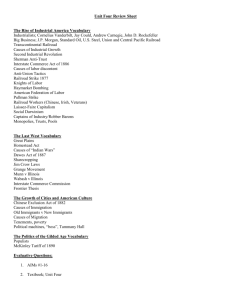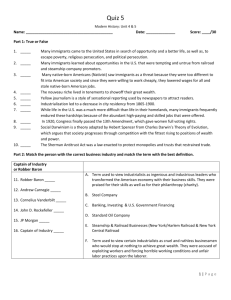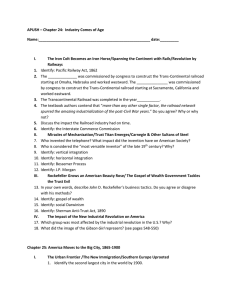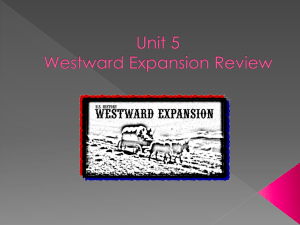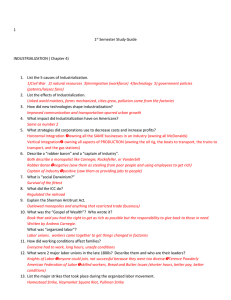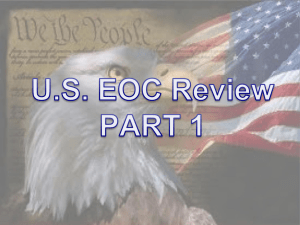APUSH Exam Review: Gilded Age (1865-1898)
advertisement
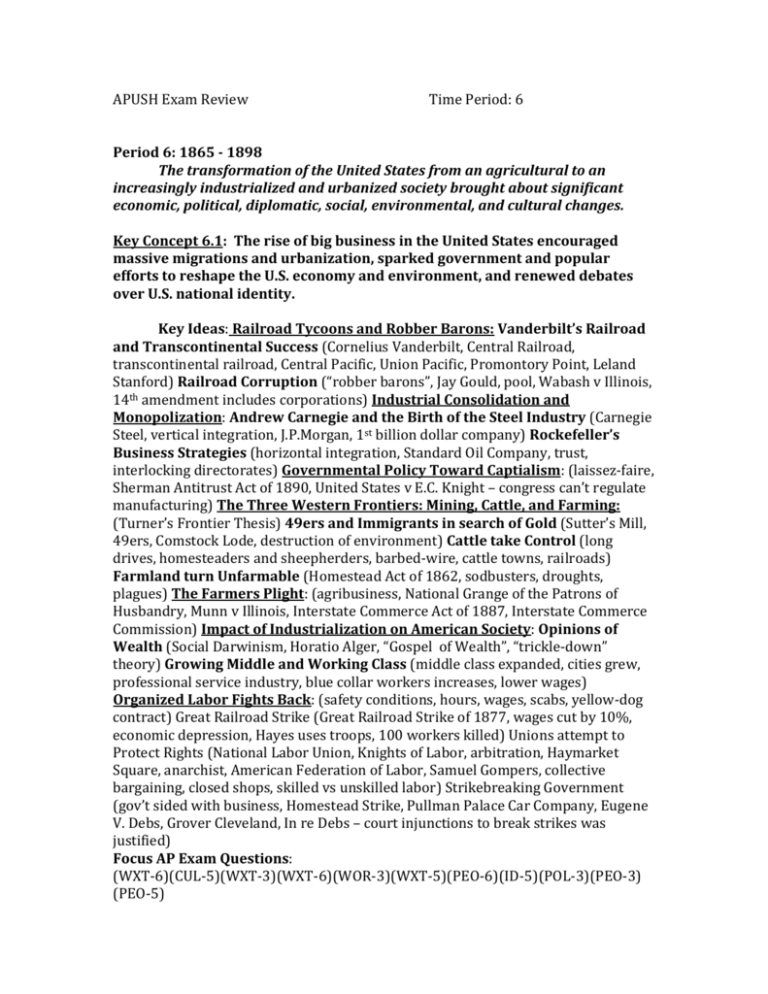
APUSH Exam Review Time Period: 6 Period 6: 1865 - 1898 The transformation of the United States from an agricultural to an increasingly industrialized and urbanized society brought about significant economic, political, diplomatic, social, environmental, and cultural changes. Key Concept 6.1: The rise of big business in the United States encouraged massive migrations and urbanization, sparked government and popular efforts to reshape the U.S. economy and environment, and renewed debates over U.S. national identity. Key Ideas: Railroad Tycoons and Robber Barons: Vanderbilt’s Railroad and Transcontinental Success (Cornelius Vanderbilt, Central Railroad, transcontinental railroad, Central Pacific, Union Pacific, Promontory Point, Leland Stanford) Railroad Corruption (“robber barons”, Jay Gould, pool, Wabash v Illinois, 14th amendment includes corporations) Industrial Consolidation and Monopolization: Andrew Carnegie and the Birth of the Steel Industry (Carnegie Steel, vertical integration, J.P.Morgan, 1st billion dollar company) Rockefeller’s Business Strategies (horizontal integration, Standard Oil Company, trust, interlocking directorates) Governmental Policy Toward Captialism: (laissez-faire, Sherman Antitrust Act of 1890, United States v E.C. Knight – congress can’t regulate manufacturing) The Three Western Frontiers: Mining, Cattle, and Farming: (Turner’s Frontier Thesis) 49ers and Immigrants in search of Gold (Sutter’s Mill, 49ers, Comstock Lode, destruction of environment) Cattle take Control (long drives, homesteaders and sheepherders, barbed-wire, cattle towns, railroads) Farmland turn Unfarmable (Homestead Act of 1862, sodbusters, droughts, plagues) The Farmers Plight: (agribusiness, National Grange of the Patrons of Husbandry, Munn v Illinois, Interstate Commerce Act of 1887, Interstate Commerce Commission) Impact of Industrialization on American Society: Opinions of Wealth (Social Darwinism, Horatio Alger, “Gospel of Wealth”, “trickle-down” theory) Growing Middle and Working Class (middle class expanded, cities grew, professional service industry, blue collar workers increases, lower wages) Organized Labor Fights Back: (safety conditions, hours, wages, scabs, yellow-dog contract) Great Railroad Strike (Great Railroad Strike of 1877, wages cut by 10%, economic depression, Hayes uses troops, 100 workers killed) Unions attempt to Protect Rights (National Labor Union, Knights of Labor, arbitration, Haymarket Square, anarchist, American Federation of Labor, Samuel Gompers, collective bargaining, closed shops, skilled vs unskilled labor) Strikebreaking Government (gov’t sided with business, Homestead Strike, Pullman Palace Car Company, Eugene V. Debs, Grover Cleveland, In re Debs – court injunctions to break strikes was justified) Focus AP Exam Questions: (WXT-6)(CUL-5)(WXT-3)(WXT-6)(WOR-3)(WXT-5)(PEO-6)(ID-5)(POL-3)(PEO-3) (PEO-5) (WXT-3) Explain how changes in transportation, technology, and the integration of the U.S. economy into world markets have influenced U.S. societies since the Gilded Age. (WOR - 3) Explain how the growing interconnection of the U.S. with worldwide economic, labor, and migration systems affected U.S. society since the late 19th century. (CUL -3) Explain how cultural values and artistic expression changed in response to the Civil War and the postwar industrialization of the United States (WXT - 7) Compare the beliefs and strategies of movements advocating changes to the U.S. economic system since industrialization, particularly the organized labor, Populists, and Progressive movements (ENV-5) Explain how and why debates about and policies concerning the use of natural resources and the environment more generally have changed since the late 19th century Key Concept 6.2: The emergence of an industrial culture in the United States led to both greater opportunities for, and restrictions on, immigrants, minorities, and women. Key Ideas: Urban Political Machines: Tweed Ring of Tammany Hall (Tammany Hall NYC, “Boss” Tweed, political machines, “honest graft”, Thomas Nast) A Second Wave of Reform: Social Gospel and Hull House (Social Gospel movement, settlement houses, Jane Addams, Hull House in Chicago, women activists) Temperance Movement (France Willard, Woman’s Christian Temperance Union – WCTU, Anti-Saloon League, Carrie A. Nation) Changing Roles of Women (Elizabeth Cady Stanton, Susan B. Anthony, National Woman Suffrage Association) Focus AP Exam Questions: (ID-6)(PEO-2)(PE0-3)(PEO-6)(POL-3)(ID-6)(PEO-4)(ENV-5)(POL-6) Key Concept 6.3: The “Gilded Age” witnessed new cultural and intellectual movements in tandem with political debates over economic and social policies. Key Ideas: Removal of Plains Indians: An attempt at a Reservation System ( Pawnee vs Sioux gave government the right to regulate with reservation system) Native Americans and War (Sand Creek, Colorado, Custer and South Dakota, Little Big Horn, Nez Perce, Chief Joseph, Apache, Geronimo) Stripping Natives of their resources and identity (Helen Hunt Jackson’s “A Century of Dishonor”, banning “Ghost Dance”, extinction of buffalo, Battle of Wounded Knee, Dawes Severalty Act of 1887) The New South: Southern Farmers Struggle (sharecroppers, economic devastation, tenant farming, cotton cash crop) Plessy v Ferguson and Jim Crow Laws ( Plessy v Ferguson – separate but equal, Jim Crow laws – segregated public facilities, literacy tests, poll taxes, grandfather clauses, lynching) Flood of Immigrants and the Lure of the City: (push and pull factors, “new immigrants”) Backlash against Immigrants (different from old immigrants, Chinese Exclusion Act of 1882, nativists, Josiah Strong “Our Country”) Makings a New Home in America (ethnic neighborhoods in major cities, “dumbbell tenements”, rise of early suburbs, disease and sanitation issues) Cultural Awakenings: Changes in Education (increase in literacy, “normal” Schools) Achievements in the Arts (Mark Twain, Stephen Crane, Theodore Dreiser, James Whistler, Mary Cassatt, Hudson River School, beautification of cities, Joseph Pulitzer and William Randolph Hearst, magazines, circus, Wild West Shows, vaudeville, professional sports) Focus AP Exam Questions: (POL-6)(ID-2)(CUL-3)(CUL-5)(CUL-6)
